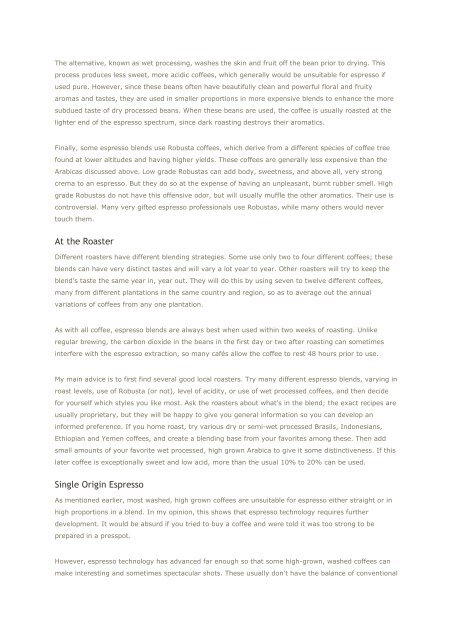The Home Barista's Guide to Espresso - Coffee Prince in Surat
The Home Barista's Guide to Espresso - Coffee Prince in Surat
The Home Barista's Guide to Espresso - Coffee Prince in Surat
You also want an ePaper? Increase the reach of your titles
YUMPU automatically turns print PDFs into web optimized ePapers that Google loves.
<strong>The</strong> alternative, known as wet process<strong>in</strong>g, washes the sk<strong>in</strong> and fruit off the bean prior <strong>to</strong> dry<strong>in</strong>g. Thisprocess produces less sweet, more acidic coffees, which generally would be unsuitable for espresso ifused pure. However, s<strong>in</strong>ce these beans often have beautifully clean and powerful floral and fruityaromas and tastes, they are used <strong>in</strong> smaller proportions <strong>in</strong> more expensive blends <strong>to</strong> enhance the moresubdued taste of dry processed beans. When these beans are used, the coffee is usually roasted at thelighter end of the espresso spectrum, s<strong>in</strong>ce dark roast<strong>in</strong>g destroys their aromatics.F<strong>in</strong>ally, some espresso blends use Robusta coffees, which derive from a different species of coffee treefound at lower altitudes and hav<strong>in</strong>g higher yields. <strong>The</strong>se coffees are generally less expensive than theArabicas discussed above. Low grade Robustas can add body, sweetness, and above all, very strongcrema <strong>to</strong> an espresso. But they do so at the expense of hav<strong>in</strong>g an unpleasant, burnt rubber smell. Highgrade Robustas do not have this offensive odor, but will usually muffle the other aromatics. <strong>The</strong>ir use iscontroversial. Many very gifted espresso professionals use Robustas, while many others would never<strong>to</strong>uch them.At the RoasterDifferent roasters have different blend<strong>in</strong>g strategies. Some use only two <strong>to</strong> four different coffees; theseblends can have very dist<strong>in</strong>ct tastes and will vary a lot year <strong>to</strong> year. Other roasters will try <strong>to</strong> keep theblend's taste the same year <strong>in</strong>, year out. <strong>The</strong>y will do this by us<strong>in</strong>g seven <strong>to</strong> twelve different coffees,many from different plantations <strong>in</strong> the same country and region, so as <strong>to</strong> average out the annualvariations of coffees from any one plantation.As with all coffee, espresso blends are always best when used with<strong>in</strong> two weeks of roast<strong>in</strong>g. Unlikeregular brew<strong>in</strong>g, the carbon dioxide <strong>in</strong> the beans <strong>in</strong> the first day or two after roast<strong>in</strong>g can sometimes<strong>in</strong>terfere with the espresso extraction, so many cafés allow the coffee <strong>to</strong> rest 48 hours prior <strong>to</strong> use.My ma<strong>in</strong> advice is <strong>to</strong> first f<strong>in</strong>d several good local roasters. Try many different espresso blends, vary<strong>in</strong>g <strong>in</strong>roast levels, use of Robusta (or not), level of acidity, or use of wet processed coffees, and then decidefor yourself which styles you like most. Ask the roasters about what's <strong>in</strong> the blend; the exact recipes areusually proprietary, but they will be happy <strong>to</strong> give you general <strong>in</strong>formation so you can develop an<strong>in</strong>formed preference. If you home roast, try various dry or semi-wet processed Brasils, Indonesians,Ethiopian and Yemen coffees, and create a blend<strong>in</strong>g base from your favorites among these. <strong>The</strong>n addsmall amounts of your favorite wet processed, high grown Arabica <strong>to</strong> give it some dist<strong>in</strong>ctiveness. If thislater coffee is exceptionally sweet and low acid, more than the usual 10% <strong>to</strong> 20% can be used.S<strong>in</strong>gle Orig<strong>in</strong> <strong>Espresso</strong>As mentioned earlier, most washed, high grown coffees are unsuitable for espresso either straight or <strong>in</strong>high proportions <strong>in</strong> a blend. In my op<strong>in</strong>ion, this shows that espresso technology requires furtherdevelopment. It would be absurd if you tried <strong>to</strong> buy a coffee and were <strong>to</strong>ld it was <strong>to</strong>o strong <strong>to</strong> beprepared <strong>in</strong> a presspot.However, espresso technology has advanced far enough so that some high-grown, washed coffees canmake <strong>in</strong>terest<strong>in</strong>g and sometimes spectacular shots. <strong>The</strong>se usually don't have the balance of conventional


